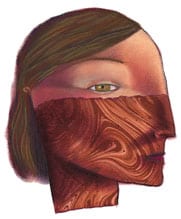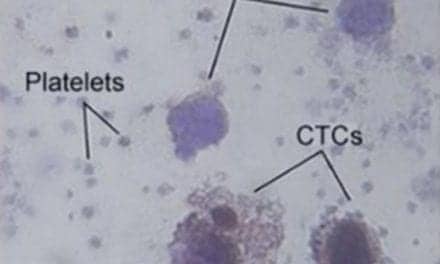 |
The human brain is programmed at birth to focus on a triangle of the central face, which includes the eyes and the perioral area. This attention to the central triangle proceeds throughout life. Aesthetic dentistry, with its focus on the smile, has capitalized on this programming.
Soft tissue rejuvenation of the perioral area provides the appropriate “frame” for the smile. Therefore, a multidisciplinary approach can provide significant improvement to the appearance of this important area of the face.
The anatomic region that makes up the perioral area extends from the subnasale (junction of columella and the upper cutaneous lip) to the mentum, and includes the nasolabial folds, upper and lower lips, marionette folds, chin, and prejowl sulci.
Aging of the perioral area is caused by intrinsic and extrinsic factors. Intrinsic factors involve the genetics of aging and the effects of time on skin, which includes hormonal effects. Extrinsic factors include chronic UV light exposure, smoking, weight loss, and illness.
The mechanical action involved in smoking creates an added hyperfunctional component to the aging skin. These so-called smoker’s lines may lead to lipstick bleed as they deepen, thus contributing to significant aging of the perioral region.
Additional changes associated with aging of this region include loss of volume with deepening of the nasolabial folds, marionette folds, and prejowl sulci. This deflation is due to soft tissue atrophy (skin and subcutaneous tissue), in addition to bony resorption of the maxilla and mandible.
The lip complex undergoes a significant change in appearance with aging, due to the histological changes noted above. Along with loss of volume, lengthening of the upper lip and decrease in vermillion show occurs, in addition to a flattening of the philtral arches and a loss of definition of cupid’s bow.
An increase in the activity of the orbicularis muscle secondary to soft tissue and bony atrophy occurs with aging, contributing to inversion of lip complex. This is most likely an adaptive response to maintain oral competence.
REJUVENATING THE AGING MOUTH
Perioral rejuvenation can be accomplished in a graduated fashion, based upon the severity of aging. A spectrum of treatment can span from minimally invasive procedures, such as fillers and botulinum toxin Type A (Botox®) for mild to moderate photoaging, to more aggressive surgical modalities reserved for severe to profound photoaging.
The key to successful perioral rejuvenation is for you to evaluate the entire aesthetic unit and treat the patient’s volume loss, as well as the skin of the perioral area. The final touch involves analyzing and appropriately treating the hyperfunctional muscular component.
A common mistake in correction of the perioral area is usually an error of omission, particularly in those patients with a moderate degree of photoaging. For instance, treating a patient’s nasolabial folds without treating the marionette folds, lips, prejowl sulcus, or fine lines of the lips may create an unfinished appearance.
Unfortunately, monetary constraints may limit the ability to accomplish the goal of total perioral rejuvenation. It is important for the physician to provide patients with realistic expectations and to educate patients with severe to profound perioral photoaging about the possible need of more aggressive surgical rejuvenation.
A plethora of dermal fillers is available for perioral rejuvenation. The ideal filler should be safe (nonimmunogenic, noninfectious, physiological), effective (nonmigration, long-lasting, natural reproducible results), and practical (cost-effective, easy application).
The fillers used for perioral rejuvenation include the following:
Hyaluronic acids—Juvéderm Ultra®, Juvéderm Ultra Plus®, Restylane®, Perlane®, Captique®, and Hylaform®; Calcium hydroxylapatite—Radiesse®; and Collagen—Bovine-Zyderm®, Zyplast®, Porcine-Evolence®, Human—Cosmoderm®, and Cosmoplast®.
These fillers are temporary and biodegradable, as opposed to polymethylmethacrylate (Artefill®) and silicone (Silikon-1000), which are permanent fillers and nonbiodegradable.
The use of liquid silicone for perioral rejuvenation is considered off-label. The concern with permanent fillers is that these implants fail to mature along with the surrounding tissues, thus creating irregular textural changes over time.
Volumizers are injected into the subcutaneous tissue and include poly(l-lactic) acid (Sculptra®), hyaluronic acid (Perlane® and Juvéderm Ultra Plus), and calcium hydroxylapatite (Radiesse).
 |
 |
| Figure 1. Minimally invasive therapy including Juvéderm Ultra, Juvéderm Ultra Plus and Botox to the perioral area results in a rested appearance. | |
 |
 |
| Figure 2. For profound nasolabial folds, direct excision followed by dermabrasion can provide dramatic results. | |
 |
 |
| Figure 3. Structural fat grafting combined with CO2 laser resurfacing rejuvenated severe photoaging. | |
PREFERRED FILLERS
Preferably, the thicker hyaluronic acid fillers Perlane and Juvéderm Ultra Plus, as well as calcium hydroxylapatite, are used in the nasolabial folds, marionette folds, and prejowl sulci. The thinner hyaluronic acid fillers—Juvéderm Ultra and Restylane—or human Collagen (Cosmoderm) are used in the finer perioral lines.
The techniques involved with injection of fillers include linear threading, serial puncture, fanning, and crosshatching.
Volumizing is best performed with fanning and crosshatching, whereas individual rhytid effacement is best accomplished with linear threading and/or serial puncture.
CONSERVATIVE TREATMENT
Conservative lip enhancement is a critical component of successful perioral rejuvenation. The key word here is conservative. Excessive augmentation of the lip complex in perioral rejuvenation creates a bizarre, unattractive appearance.
The best way to conceptualize lip enhancement is by definition, plumpness, and eversion. The lips are defined by adding filler below the vermillion border. Plumpness (volume) is accomplished by injecting the tubercles of the lips (three in the upper lip and two in the lower lip). Eversion of the lip is accomplished by injecting submucosally in the region of the gingival surface of the lip above the frenulum.
The final touch involved in minimally invasive rejuvenation of the perioral region is the addition of Botox. The important point in the use of chemodenervation in perioral rejuvenation is accurate placement of low doses in the perioral musculature.
The benefits of Botox are twofold. First, there is improvement in the hyperdynamic movements seen in the aging perioral region, which contributes to rhytid formation. Second, there is less chance of migration and theoretical increase in longevity of fillers because of less mechanical forces acting on the implant.
The four major muscles treated include the orbicularis oris, mentalis, depressor anguli oris, and levator alequi nasi superioris. The orbicularis oris muscle is injected in doses of one to four units per lip at the vermilion border. It is important to treat the upper and lower lip to prevent asymmetric movement of the lip complex. This injection improves perioral rhytids and aids in eversion of the lip. Also, it is a valuable adjunct to both treatment of fine lines of the lips, as well as for lip enhancement.
The mentalis muscle is injected with eight to 10 units at the mentum. This improves “cobblestoning” (peau d’orange) of the soft tissues of the chin. The depressor anguli oris is injected with three to five units per side in the region of border of the mandible just anterior to the masseter muscle. This improves the parentheses rhytids formed in the lateral chin region. In addition, this injection contributes to elevation of the oral commissure along with the placement of filler in the marionette region.
|
See also “Vo-lip-tuous,” by Joseph P. Niamtu III, DMD, in the March 2008 issue of PSP. |
Treatment of the levator alequi nasi superioris with Botox can help in effacing the extremely deep nasolabial folds, thus acting synergistically with dermal fillers. No more than one to two units are used because of the potential to depress the upper lip with smiling. This injection is performed just lateral to the nasoalar crease.
As mentioned earlier, severe to profound perioral aging requires surgical intervention. This may involve facelifting, direct excisional techniques, placement of permanent implants, structural fat grafting, and/or ablative skin resurfacing via CO2 laser, dermabrasion, or chemical peel.
A combination of structural fat grafting to the nasolabial folds, marionette folds, and prejowl sulci (reinflating the deflated balloon)—along with CO2 laser resurfacing to improve skin texture and fine rhytids—has proven to be a valuable technique.
For severe nasolabial folds, direct excision techniques followed by skin resurfacing provide dramatic results.
Timothy M. Greco, MD, FACS, received his Doctorate of Medicine from Hahnemann University School of Medicine, Philadelphia, and did his residency training at Thomas Jefferson University Hospital, Philadelphia, specializing in head and neck surgery. He is fellowship-trained in facial and reconstructive surgery and is a Clinical Assistant Professor at the University of Pennsylvania School of Medicine. Greco is board certified by the American Board of Facial Plastic and Reconstructive Surgery and the American Board of Otolaryngology, Head and Neck Surgery. He can be reached at (610) 664-8830.



